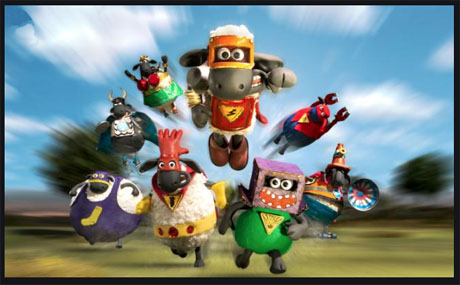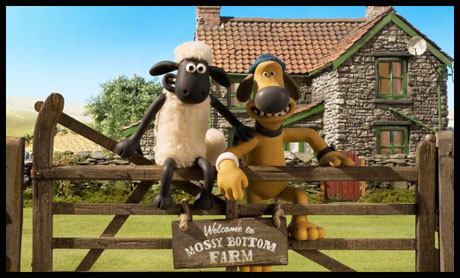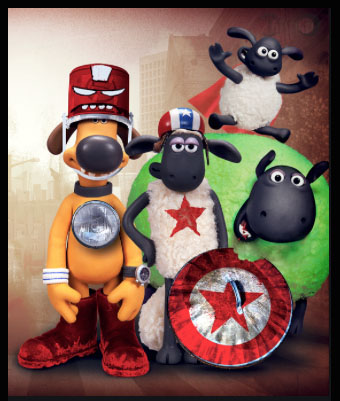
Fresh-off the second feature Farmageddon, the Shaun the Sheep series is back for a brand new 6th season, premiering this Tuesday, March 17th on Netflix. Series Director Tom Parkinson previews the episodes and shares what he loves most about these iconic characters.
Tom Parkinson: They’re like a little family now. We’ve got the Farmer. We’ve got Bitzer, the long-serving dog and Shaun and the flock. There are so many different characters, and it’s a very warm world to spend time in. I love spending time with them all. And the appeal to a lot of people because it’s so popular around the world. It’s hard to put your figure on why exactly they’re so popular, but I think it has something to do with… the comedy and the warmth that comes off of them.

JM: 20 new 7-minute episodes [6 minutes without the open and credits]. What was the brainstorm process like in coming-up with and determining the 20 episodes?
TP: We’ve got a few feature films out in the world now for “Shaun”. And there was a real conscious decision for this season to bridge the gap between the seasons that have come before and the feature films. When we decided on storylines for this season, we wanted to make them a bit bigger – a little more dramatic – a bit more cinematic. Before we had a lot of episodes that have been particularly funny, but I think for this season in particular, we wanted to amp up the drama. In seasons gone by… someone would get stuck in a toilet or someone would get a bucket on their head… little vignettes of comedy based around these small incidents. For this one we wanted to tackle bigger genres… bigger cinematic kind of ideas. We still only have 6 minutes to tell these stories in, so it’s quite a tall order trying to make these bigger stories land in 6 minutes.
JM: I had the chance to screen 4 of the episodes. One of them that absolutely feels like a movie is the superhero episode “Super Sheep”. Shaun becomes a superhero, and there are a few other surprises in it. What were the creative inspirations overall for this episode?
TP: When you see it, it’s obvious that it’s very much based in that comic book world – that Marvel Universe. We researched that a bit. We’re all big fans of that stuff… coming out of “Spider-Man: Spider-Verse”, we wanted to delve as deep as we could into there. It’s that 2D vibe with that little sequence in the middle. Nonsense superheroes always appeal to me – the idea of making up silly attributes for superheroes. We tried to push that as far as we could.
JM: And how was it designing the different capes and outfits for the characters?
TP: That episode specifically was directed by Steve Cox, who spent a lot of time designing those. He had a lot of fun with the silly and nonsense superhero characters he could think of. In their own right, they could be little spinoff shows for themselves. Shaun could have his own spinoff superhero show on the back of that episode. I think Steve did such a great job with the designs and ideas behind it.
JM: Maybe Season 7 could be an entire superhero season.
TP: Yeah. Why not? All superheroes. (laughs) Fighting crime on the Mossy Bottom. And it builds itself nice because the pigs are always the villains every time anyway. They fit in quite nicely as the arch villains.

Tom Parkinson – and his cast
JM: They’re the villains as well in the episode “Hot to Trot”, which satirizes “Dancing with the Stars”. I feel like just doing stop-motion animation in general is tough enough, but giving the characters dance moves I feel like would be really difficult.
TP: Yeah that was a step up as well. That was quite a tough one. The strength of that [episode] was in the storyboarding. The animatics we created – we were pretty specific with the timing and the dance routines. They were pretty spot on. The animators did an incredible job. They knocked it out of the park – the lighting and everything. It does feel like one of those shows. It’s a real homage to the big spectacular shows. A lot of work had to go into the timing of that one. I think we pulled it off.
JM: And then in the “Teddy Heist” episode, it not only plays off of heist movies, but it’s also partially a satire on “Antiques Roadshow”. And I think what you guys do with that is so smart. Are you and your team constantly watching shows and movies looking for examples to incorporate into these episodes?
TP: I think they’re always there latent in the background. The shows you’ve mentioned we’ve grown up watching these shows or they’re always on Saturday nights. I don’t think we all pile in to watch TV to do the research – they’re all just there. Certainly in England, that “Antiques Roadshow” is such a familiar place… even the theme tune. It was hard not to actually put the original theme into the show to make the audience go, “Oh yeah. We know where we are.” The archetypes of TV, it’s really easy to lampoon them, isn’t it? I’m glad that you mentioned that because it does translate across the Atlantic. You guys have the same genre show.
JM: We love “Antiques Roadshow” here in America. It’s quite a phenomenon. And the spin you put on it is really clever. One of the other ones I watched is your Halloween themed episode “Pumpkin Peril”. There are a lot of… snails in that episode.
TP: That was a treat, that one. I definitely wanted that one to be an homage to those John Carpenter zombie movies – and try to push it as far as we could. I know it’s a kids show, “Shaun”, at least it’s watched by a lot of kids. And that one I wanted it to be a little more scary than it would’ve been in past seasons. So we leapt into that heavily with the music and the lighting and that classic horror vibe. I think it works. I think kids can get in there. What do you think?
JM: Oh yeah. It gives you that intensity just enough but it’s still really funny.

TP: I think there’s enough comedy of when things get too dark… but they’re just snails at the end of the day. So I think that saves it. (laughs) It saves it from being a real dark night.
JM: And that’s one of the brilliant things you’ve been able to do with “Shaun the Sheep” – is make it appeal to kids and adults.
TP: I think that’s why it has endured, actually. In some territories, I’m told it’s more popular with adults than kids. It’s got that classic silent comedy thing. It’s acted out really well. There’s subtle comedy and then there’s proper, falling over laugh out loud comedy as well. There are layers that kids can dig it and adults can get into it as well. It’s a great show to work on. This is my first season working on the show, and I loved it.
JM: I know you started at Aardman, and then you left to work on other animation projects and came back. Were there techniques and things you remember from the first time at Aardman that you used and applied on this season of “Shaun”?
TP: Well, to be honest No because I come from a more 2D background. I’ve worked on kids TV and proper cartoon stuff. Although I was a storyboard artist at Aardman, I never did any stop-frame, so this was my first stop-frame outing. That sounds insane, but the fact is that the crew was incredible. The show had… directors working on each episode, so I felt like I was in good hands. I was just trying to make good stories. I think the same principles apply when you’re making 2D or stop-frame or CG. You’re telling stories.
Fingers crossed that I managed to fit in without completely… I think my in-experience at stop-frame wasn’t really a problem. It was quite nice to come at it from a different angle. I’m used to 2D comedy where you can get away with more gags per minute and throwaway gags, and I tried to apply a bit more of that into this.
JM: And you pack a lot into just 6 minutes. Is it challenging sometimes to leave a lot of material out because you’re sort of limited to just 6 minutes?
TP: Yeah, definitely. For me, that was the big wrestle with this season – trying to get this bigger storylines and whittle them down into something that made sense and was entertaining and fun. I feel a bit like we made 20 half-hour ideas. We made 20 short films, in a way – each of them being 6 minutes. We piled a lot in. It’s a hell of a lot of stuff going on.

JM: And one of the other things you’re able to do is incorporate 4 new, prominent characters. What was the process like in deciding on these four characters, including a squirrel and another farmer?
TP: We wanted to open up the world a bit more and offer something different for this season. We wanted to get some new characters in there. Rather than wholesale changes, you’ll see that they’re kind of sprinkled in lightly. We’ve got the same cast as usual, and then we’ve put in a few episodes with these new characters. I’m imagining next season they’ll have bigger plots and episodes based on those characters, specifically.
We’ve got a squirrel called Stash – this hyperactive squirrel. You can hardly see her when she moves. There’s a really great episode that she’s in (“Squirreled Away”). We love working with her. We use this time-slice technique for her movement: a part-camera, part-CG technique, which is really fun to watch. And then there’s a new farmer who’s moved in next door to our Farmer. He’s the modern equivalent. He’s got a social media site, and he’s really popular. He’s good looking. He’s really successful. He’s the kind of the opposite of our Farmer. He’s a nice new antagonist for the show. We’ll probably bring him into a bit more when we do new episodes again.
JM: Good. So you’re already thinking about a 7th season – more episodes?
TP: Well I hope so. It’s not for me to say, but the show can go on and on. I think there’s so many possibilities. The films are proving that. It’s a case of expansion. I sort of feel like you can do anything with them. It’s a great series because you can push it into almost any format. And it seems to be working in the way it’s going. So why stop here?
- INTERVIEW: Jeff Fowler On “Knuckles” And “Sonic 3” - April 22, 2024
- INTERVIEW: “Inside Out 2” Director And Producer On Pixar Sequel - April 16, 2024
- INTERVIEW: “Puffin Rock And The New Friends” And 25 Years Of Cartoon Saloon - April 10, 2024


 March 12th, 2020
March 12th, 2020  Jackson Murphy
Jackson Murphy  Posted in
Posted in  Tags:
Tags: 






